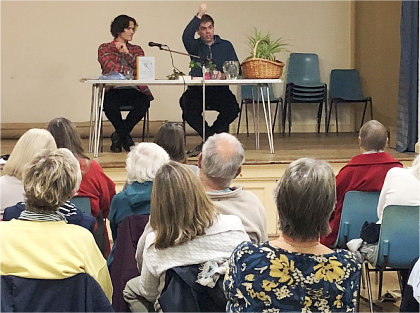

The first talk in our Autumn Series followed the format of a Gardeners’ Question Time panel. We were pleased to obtain the expert services of Martyn Cox and Peter Rogers – neither of them were phased by any of the questions thrown at them!
 Martyn is an award-winning gardener, writer and presenter and now lives in Southsea. Peter lives locally and enjoys entering local shows and has his own gardening business.
Martyn is an award-winning gardener, writer and presenter and now lives in Southsea. Peter lives locally and enjoys entering local shows and has his own gardening business.
Here are just some of the questions that many of the audience wanted to ask about.
Q: How to eradicate one of the most common garden weeds – Oxalis Cornucata (Wood Sorrel)?
This invasive successful self- seeding garden plant has either purple or green leaves and small yellow flowers. It is very difficult to eradicate and any pieces of root left in the soil will regrow. The best way to keep it at bay is to persevere in pulling it up as it appears and don’t give it chance to spread. In large areas one method,(which can used to eradicate any weeds), is to deprive the soil of light to weaken the growth. This can be done by covering the area completely with black plastic or even cardboard
Q: Blossom End Rot – How to identify it and what is the solution?
A brown and leathery spot at the base of the plant (most commonly tomatoes,peppers, squash, cucumber, and melons) It is not a disease but is caused by a calcium imbalance within the plant. It is common in a growing season that starts out wet and becomes dry.
One of the best ways to prevent this is to establish a watering routine and to use fertilisers low in nitrogen and high in phosphorous. Damaged fruits should be picked and discarded.
Q Sooty Mould – how to identify it and how to deal with it?
Sooty Mould is a secondary attack and grows on plants (usually on the back of leaves) that have already been damaged by aphids. The aphids secrete a sticky dew that allows the sooty mould to spread. So the remedy is to deal with the aphids that cause the attack (mealy bugs, scaly bugs) There are many chemical and non-chemical ways to deal with them. Make sure damaged leaves are disposed of.
Q: Fuschia Gall Mite
This is a sap sucking mite specific to fuschias (particularly in the south of England) which causes galling and distortion of the stem ends and leaves. Some advice is to destroy the whole plant and start with fresh specimens but cutting hard back to healthy growth will sometimes enable the fuschia to regrow normally. If plants are being overwintered, prune them hard back to ground level and destroy diseased growth.
Q: How to grow ornamental grasses – in pots or in the ground?
Grasses are normally easy to grow but check if they are hardy and maybe give some protection in very cold weather. Some of the more compact varieties will thrive in pots in a mixture of compost and John Innes but make sure they do not become waterlogged. Larger varieties such as Miscanthus are best planted in the ground.
In conclusion, it was suggested by the panel that by positioning the ‘Right plant in the right place’ meant that many of the problems we face in our gardens can be avoided. A strong and healthy plant is more like to survive disease and pest infestation.
There were many more questions and it was a lively and enjoyable evening.